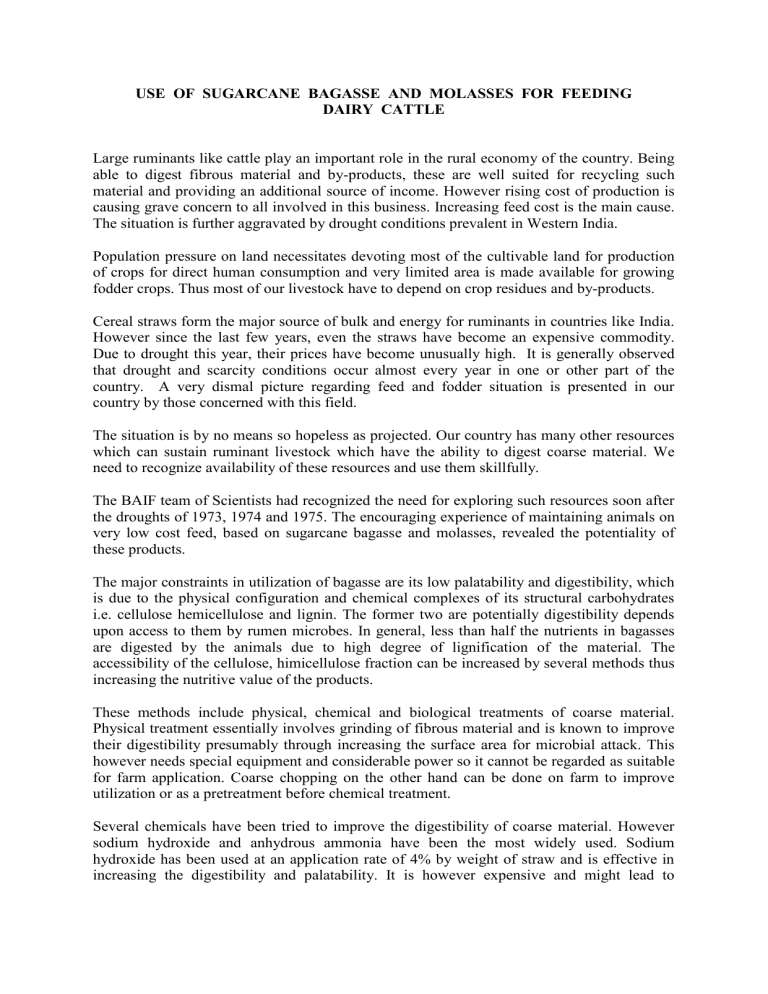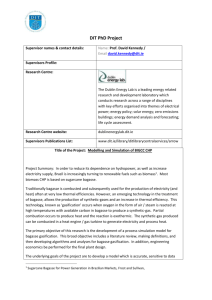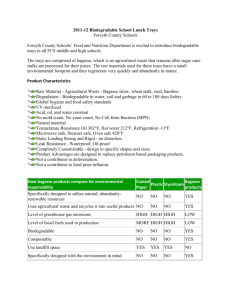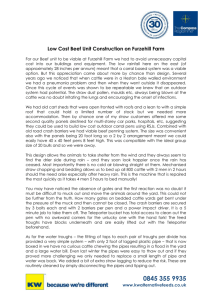Use Of Sugarcane Bagasse And Molasses For Feeding Dairy Cattle

USE OF SUGARCANE BAGASSE AND MOLASSES FOR FEEDING
DAIRY CATTLE
Large ruminants like cattle play an important role in the rural economy of the country. Being able to digest fibrous material and by-products, these are well suited for recycling such material and providing an additional source of income. However rising cost of production is causing grave concern to all involved in this business. Increasing feed cost is the main cause.
The situation is further aggravated by drought conditions prevalent in Western India.
Population pressure on land necessitates devoting most of the cultivable land for production of crops for direct human consumption and very limited area is made available for growing fodder crops. Thus most of our livestock have to depend on crop residues and by-products.
Cereal straws form the major source of bulk and energy for ruminants in countries like India.
However since the last few years, even the straws have become an expensive commodity.
Due to drought this year, their prices have become unusually high. It is generally observed that drought and scarcity conditions occur almost every year in one or other part of the country. A very dismal picture regarding feed and fodder situation is presented in our country by those concerned with this field.
The situation is by no means so hopeless as projected. Our country has many other resources which can sustain ruminant livestock which have the ability to digest coarse material. We need to recognize availability of these resources and use them skillfully.
The BAIF team of Scientists had recognized the need for exploring such resources soon after the droughts of 1973, 1974 and 1975. The encouraging experience of maintaining animals on very low cost feed, based on sugarcane bagasse and molasses, revealed the potentiality of these products.
The major constraints in utilization of bagasse are its low palatability and digestibility, which is due to the physical configuration and chemical complexes of its structural carbohydrates i.e. cellulose hemicellulose and lignin. The former two are potentially digestibility depends upon access to them by rumen microbes. In general, less than half the nutrients in bagasses are digested by the animals due to high degree of lignification of the material. The accessibility of the cellulose, himicellulose fraction can be increased by several methods thus increasing the nutritive value of the products.
These methods include physical, chemical and biological treatments of coarse material.
Physical treatment essentially involves grinding of fibrous material and is known to improve their digestibility presumably through increasing the surface area for microbial attack. This however needs special equipment and considerable power so it cannot be regarded as suitable for farm application. Coarse chopping on the other hand can be done on farm to improve utilization or as a pretreatment before chemical treatment.
Several chemicals have been tried to improve the digestibility of coarse material. However sodium hydroxide and anhydrous ammonia have been the most widely used. Sodium hydroxide has been used at an application rate of 4% by weight of straw and is effective in increasing the digestibility and palatability. It is however expensive and might lead to
pollution. Ammonia treatment is less rapid than sodium hydroxide and its applicability is limited for obvious reasons.
Biological treatment of fibrous material is attracting attention of the scientists all over the world. Certain fungi and mushrooms are shown to improve the energy availability from straws. Further studies are therefore needed for developing a technology suitable for application at farm level. This approach is being explored by BAIF workers.
Studies hsve been carried out on sugarcane bagasse at BAIF to develop low cost feed. The chemical composition of bagasse is indicated in the following table and is comparable to cereal straws which are conventionally used for feeding cattle.
Chemical composition of sugarcane bagasse (% DM)
CP
2.86
CP
31.76
EE
0.80
Ash
4.76
KPE
56.82
NDF
78.60
ADF
54.36
Initial studies on this product were aimed at producing a low cost feed for maintenance of animals during scarcity conditions. A feed of following formulation was found to be quite effective for maintenance of breedable animals in good condition.
Bagasse
Molasses
Concentrates
62%
17%
Mineral Mixture 1% &
Vitamin AD3 @ 200 gm/M.T.
20%
Further studies on growing animals indicated that a feed of following formulation can support growth rate of 400 gms per day in cross-bred heifers.
Bagasse
Molasses
Concentrates
Urea
40%
18%
40%
Mineral Mixture
Vitamin AD3 as earlier
1%
1% &
In these formulations, molasses was used to improve the palatability and provide energy at low cost. Urea was used as a source of nitrogen.
Due to low palatability and digestibility of sugarcane bagasse, its inclusion at higher levels was not possible. It was therefore, considered worthwhile to attempt to improve its palatability and energy availability through a suitable treatment.
Steam treatment was tried because of easy availability of steam at the sugar factory where sugarcane bagasse is produced. To find out optimum processing condition, a pressure vessel
(40 kg capacity) was fabricated in collaboration with sugar factory and bagasse was subjected to steam pressures of 5, 7 and 9 kgs/ cm for 30 and 60 minutes. During treatment, the vessel was kept rotating at 12 RPM for uniform distribution of steam / heat. Steam was released
from the vessel at the end of the treatment through a quick release valve. The samples of bagasse untreated and treated according to the method described were analysed for chemical composition and invitro digestibility. These studies indicated an improvement in invitro digestibility of 23-64% for various treatments. It was further observed that treatment of bagasse at 7 kg / cm
2
steam for 30 minutes resulted in maximum digestible dry matter yields.
The bagasse thus treated showed invitro digestibility of 51% as compared to 35% for the untreated bagasse untreated and alkali (sodium hydroxide) treated bagasse. The results of the animal feeding trial indicated approximately 100% improvement over controls in the voluntary dry matter intake through bagasse. The growth rate of animals fed steam treated, alkali treated and untreated bagases were 385, 182 and 124 gm / day respectively. The feeding value of bagasse after treatment improved considerably.
Further studies on steam treated bagasse with lactating animals were carried out by including it in a pelletised complete feed at 40%. The results have shown that a daily milk production of 10 litres can be maintained by this feed. In mashed form, steam treated bagasse based complete feed has been found to support a production of 8-9 litres of milk/day. The level of bagasse inclusion in this case was however lower at 30% of the feed. These studies have clearly indicated the potential of this material in economic feeding of cattle.
The following precautions need to be taken while feeding bagasse:
1.
Avoid usage of fungus affected bagasse and spoiled molasses.
2.
If urea is used in the feed, care should be taken to mix it uniformly in the diet.
3.
In case, molasses is diluted, such feed should not be stored.
4.
Bagasse feed is to be introduced slowly as the animals take some time to adapt to it.
5.
Adequate water should be made available to the animal.
In case of steam treatment of bagasse, care needs to be taken on the following points.
1.
To fabricate a vessel that can withstand the pressures envisaged due during treatment.
2.
To introduce steam at several points to aid uniform distribution. Alternatively, vessel may be kept rotating to achieve the same.
3.
If the material is used in fresh form for mixing with molasses, storage of feed is to be avoided.
4.
Sun drying of the treated material is recommended if storage is desired.
STUDIES ON STEAM TREATMENT OF SUGARCANE BAGASSE FOR FEEDING
OF DAIRY CATTLE – A REVIEW
SUMMARY
Studies were undertaken to assess the effects of high pressure steam treatment (5, 7, 9 kg/cm
2 for 30 and 60 min) on chemical composition and digestibility invitro of sugarcane bagasse, paddy straw and sorghum straw. Treatments resulted in significant falls in the neutral detergent fibre (NDF), especially the hemicellulose content, and in pH. Soluble carbohydrates and volatile acids increased with the treatment while acid detergent fibre (ADF) remained constant. The improvement in true dry matter digestibility invitro (IVTDMD) observed were
23-64% (sugarcane bagasse), 19-36% (paddy straw) and 31-42% (sorghum straw) with increasing steam pressures and periods compared to untreated samples. The digestibility of cell wall constituents (CWC) improved with steam treatment in all three roughages. The dry matter losses were 0.9-20%, 17-39% and 1-22% for sugarcane bagasse, paddy straw and sorghum straw, respectively.
The results of animal feeding trials indicated approximately 100% improvement over untreated bagasse in the DMI of bagasse. The digestibility coefficients for organic matter
(OM) and crude fibre (CF) were increased by 7 and 20 units over untreated controls. The growth rated of animals fed steam-treated, alkali-treated and untreated bagasse (all with a concentrate supplement) were 385, 182 and 124 g/d, respectively.
Further studies with complete feeds based on untreated and steam-treated sugarcane bagasse for growing heifers revealed significantly higher weight gain for treated bagasse based feed
(775 us. 573 g/d). Feed efficiency (DM consumed / kg weight gain) was better for treated bagasse group (10,6) than untreated bagasse group (12,7). Economics of weight gain was also favourable for treated bagasse as compared to untreated control (9.34/kg, respectively).
Two experiments were conducted with steam-treated bagasse based complete feeds in lactating cows. The first experiment used complete feed in mash form (containing 30% treated bagasse) while in the second experiment pelletised feeds with 35 and 40% treated bagasse were tried. In the first experiment (140 days) milk production was 9.8 and 9.4 kg/d in experimental and control groups respectively. No significant differences were observed in milk fat content. The feed cost of milk production was lower in experimental group (Rs.
1.35/kg) than in the control group (Rs. 1.51/kg).
In the second experiment of 35 days duration, significantly higher DMI and milk yield was observed in animals offered complete feeds as compared to the conventionally fed controls.
The expenses on feed (Rs./day) was comparable in all three groups while feed cost per kilogram of milk production was lower in animals fed experimental rations.
INTRODUCTION
The shortage of conventional feeds and fodders in countries from the tropical and subtropical regions is well recognized. However, cattle development is taken up in these countries on a large scale in view of its potential as a source of income and employment.
There is need to explore the use of non-conventional feed material. Sugarcane is one of the crops which has enormous potential for capturing solar energy and providing high biomass yield. The two approaches to utilize sugarcane as cattle feed include: (i) use of by-products out of manufacture of sugar, namely bagasse and molasses, and (ii) use of the cane as such.
In Western India, principally in the state of Maharashtra, a large number of sugar manufacturing units are located in rural areas and are mostly set-up in co-operative sector with crushing capacities ranging from 1,000-7,000 M.T./day. Almost 100 such co-operative sugar factories are presently in operation in the Maharashtra state. All these factories utilize bagasse as fuel for their boilers but are still left with substantial quantities of surplus bagasse.
The availability of surplus bagasse is generally 3-4%of the cane crushed (about 30% sugarcane crushed out as bagasse). Excess steam is available in all the units throughout the crushing season (120-150 days) at very low cost.
High pressure steam treatment of low-quality roughages has been reported to increase energy availability (Bender et.al. 1970, Guggolz et.al. 1971, Campbell et.al. 1973, Phoenix et.al.
1974, Preston, 1974, Donefer and Pathirana, 1976, Oji and Mowat, 1978).
In view of the availability of steam and bagasse in substantial quantities and at low cost, studies were undertaken to investigate the use of steam treatment on bagasse for improving its nutritive value and palatability. The effect of steam treatment was also investigated on other roughages like paddy and sorghum straws while work on the growth and location was pursued only with sugarcane bagasse in view of its availability at low cost.
COMPLETE FEED
(Scientific and Economic Method of Feeding Dairy Cattle)
Feed contributes 65-70% of the total expenditure of raising dairy cattle. Because of rising cost of the feed stuffs many dairy farmers feel that milk production is not a profit making activity. To exploit milk production potential of cattle and buffaloes, it is necessary to feed them diet containing proteins, energy, fat, minerals and vitamins as per their requirement.
While doing so their total dry matter requirement must also be fulfilled. This can be achieved by feeding complete feeds. In some developed countries feeding of high producing dairy cattle is simplified by using complete feed technology.
What is complete feed?
Complete feed is a homogenous mixture of feed ingredients (concentrate and roughages), which contain nutrients (proteins, carbohydrates, fiber, fat, minerals and vitamins) and also meet the dry matter requirement of animals. It can be fed either in mash form as total mixed ration (TMR) or pelleted by using expander-extruder technique.
Complete feed is prepared by using agricultural wastes, crop residues like wheat straw, paddy straw, bajra straw, dry grasses and by products like oil seed cakes, brans and molasses. In
Maharashtra there is scarcity of green fodder and the situation becomes worst in summer months. In such conditions complete feed is the appropriate option to meet requirement of animals.
Complete feed is more balanced feed and can be fed as per requirement of the animal. It is easy to regulate feed intake of the animal with complete feed. Complete feed is a better option for land-less and small farmers for whom there is always shortage of green fodder for their animals. The organized farms and peri-urban dairies can also use complete feed with advantage.
Method of preparation of complete feeds:
Several combinations of roughage and concentrate feed ingredients can be used to prepare complete feed for lactating cows, growing heifers and dry animals. Four combinations are given as an example for different type of animals.
Crop residues and locally available by products are used in the formulation in proportion as per requirement of the animals.
COMPLETE FEED FORMULATIONS
(For one tone feed)
SR.
NO.
INGREDIENTS MIXTURE
NO.1 (kg)
MIXTURE
NO.2 (kg)
MIXTURE
NO.3 (kg)
MIXTURE
NO.4 (kg)
1.
Sorghum/maize/
Bajra grains
2.
Groundnut/
Soybean
100
150
3.
Sunflower deoiled cake
100
4.
Wheat / Rice Bran 240
5.
Molasses
6.
Wheat straw/
Sorghum straw/
Wheat straw/
Dry grass
7.
Mineral mixture
100
300
10
40
150
50
250
100
400
10
50
100
40
200
100
500
10
50
50
40
100
100
650
10
Total (kg) 1000kg 1000kg 1000kg 1000kg
Formulation No 1: - For high producing dairy cows (more than 20 kg milk/day).
Formulation No 2 & 3: - For medium producers, growing heifers and pregnant cows.
Formulation No 4: - For dry animals.
In complete feed all the ingredients are homogenously mixed leaving no chance to animals for selection. The expander -Extruder machine can be used for pelleting diets containing high roughage components. Overall effect of this provides all the nutrients as per feed requirement of animal. Complete feed increases fat content of milk by maintaining right proportion of acetic and propionic acid in 3:1 proportion and resists rumen acidity. This also affects microbial flora of rumen by increasing cellulolytic bacteria in rumen. Digestibility of proteins increases by feeding complete feed.
The feeding trials conducted at BAIF Development Research Foundation at Urulikanchan in
Maharashtra have shown usefulness of complete feed for dairy cattle.
Advantages of feeding complete feed:
1.
Increase in intake of feed by 10 to 30% because of better palatability.
2.
Improvement in nutritional quality of feed to some extent.
3.
Maintains quality of milk in terms of fat and SNF content.
8
14
20
26
32
4.
Pelletization of feed can reduce bulkiness of the feed, which helps in lowering packing and transportation cost.
5.
Marked increase in milk yield due to feeding complete feed.
Feeding of Densified Feed to Different Categories of Dairy Cattle:
Live Wt. Kg. Crude gms/day
For Growing Heifers:
100 507
Protein TDN Kg/day DM Required
Kg/day
Densified Feed
Kg/day.
150
200
250
682
858
995
For Pregnant Heifers:
1.8
2.5
3.15
3.7
3.9
5.25
6.6
7.65
4.3
5.8
7.3
8.5
250-350 1265
For Adult Dry Cows:
400
450
648
720
5.65
3.6
4.0
9.73
7.2
8.0
10.8
8.0
9.0
500 810 4.5 9.0 10.0
Lactating Cows Weighing 400-450 Kg Body Wt. Yielding Milk With 4.5% Fat:
Milk
Kg/Day
Yield Crude Protein
Gms/Day
TDN Kg/Day DM Required
Per Day
Densified Feed
Per Day
1264
1762
2235
2688
3182
6.5
8.5
10.5
12.5
14.6
8.5
11.75
14.9
17.9
21.2
10.0
14
17.5
21.0
25.0






